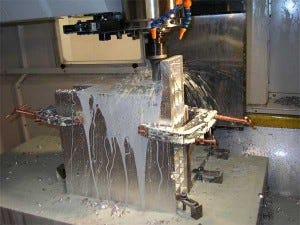Cloud production AKA Makerbot Prime
At AND 1 we had a 3D printer. It was super expensive but it shortened the time from a drawing to a physical object by weeks. The file that drove the printer could also drive the CNC machines in Asia that cut the aluminum molds we used for production.
Makerbot has innovated in the 3D printing space by making the printer cheaper and establishing a marketplace for the digital files that create the physical objects. But for the people who want high quality, durable parts with real utility, will it ever be possible to have a CNC machine in your house for metal objects or an injection mold set up for TPU parts? Maybe, but why can’t I pay Makerbot to make my file in hard plastic or metal? Wouldn’t enough people want this makerbot Prime service to support a CNC machine in Brooklyn? I bet they would — and as the peer-to-peer economy grows, cloud production should grow with it.
Amanda had a great post Monday on the Peer to Peer Universe that will allow “anyone with a car to become a one-person Fedex in the same way that AirBNB has made everyone a hotelier.” She points to the opportunities for entrepreneurs to build the coordination platforms that will make all this possible.
There seem to be two distinct ways entrepreneurs are pushing us into this new peer-to-peer universe faster and a third that I think will emerge soon. It is important to know which of the structures you are building and focus on optimizing against that goal as money starts moving around between buyer and seller.
Marketplaces: There is great value in coordinating buyers and sellers and removing friction in an existing transactable space. (eBay, Half.com, ETSY, CustomMade, ThreadFlip). This is traditional behavior at web scale.
Collaborative Consumption: A technology platform that coordinates demand and balances it across distributed capital assets. These platforms unlock a previously latent pool of demand (usually with very efficient unit pricing) and help individual suppliers maximize the value of their assets and time with better utilization rates. (Uber, TaskRabbit)
Both types of companies are solving a logistics problem — removing coordination friction that used to make a transaction impossible — but as this granularity of supply takes hold, the rules of utilization rates and economies of scale will still hold in the world of physical assets. I think this will inspire a third group of companies with logistics at their core: Cloud Production.
In the transition from digital to physical (online to offline) platforms that enable full utilization/rapid amortization of wholly-owned capital assets over a greater base of creators should emerge. Today’s cloud services are maximizing utilization of the physical devices required to store and serve digital goods. Cloud services on in teh digital space have changed the math of the creator’s business. Instead of budgeting for a certain level of demand — and buying servers to safely cover that projected level of usage, companies/creators can make sure the unit economics work for each unit of demand and architect for infinite scale. Up front costs are dramatically decreased and more ideas come to market.
This same transition should occur around the physical production of goods where economies of scale are powerful. With cloud production niche products can meet global demand and achieve greater scale than ever before. The innovation will be in the coordination and technology required to aggregate individual creativity and produce increasingly specialized, niche products with higher production value and quality.


